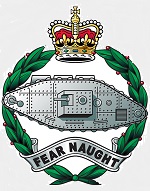Dragon DRR60311 British Challenger 2 Main Battle Tank with Bar Armour - Operation Iraqi Freedom, 2003 (1:72 Scale)
"Obsolete weapons do not deter."
- British Prime Minister Margaret Thatcher
 The Challenger 2 is the current main battle tank of the British Army. The hull is similar to that of the Challenger I, as is the powerpack, but the turret has been redesigned to fit updated armament, and the tank is in many ways a completely new tank. The first production versions appeared in mid-1994, boasting a carbon dioxide laser rangefinder, thermal-imaging and fully computerized fire-control systems, giving a high first-round hit probability. In addition, turret traverse is all electric and the gun is fully stabilized. It also has the capacity to be fitted with the Battlefield Information Control System (BICS) in future years, to give even greater combat capability. A dozer can be fitted to the front of the hull. Nearly 400 were ordered by the British Army, with 18 being exported to Oman.
The Challenger 2 is the current main battle tank of the British Army. The hull is similar to that of the Challenger I, as is the powerpack, but the turret has been redesigned to fit updated armament, and the tank is in many ways a completely new tank. The first production versions appeared in mid-1994, boasting a carbon dioxide laser rangefinder, thermal-imaging and fully computerized fire-control systems, giving a high first-round hit probability. In addition, turret traverse is all electric and the gun is fully stabilized. It also has the capacity to be fitted with the Battlefield Information Control System (BICS) in future years, to give even greater combat capability. A dozer can be fitted to the front of the hull. Nearly 400 were ordered by the British Army, with 18 being exported to Oman.
Pictured here is a 1:72 scale British Challenger 2 main battle tank equipped with Bar armour used to defeat incoming RPG rounds.
Sold Out!
Dimensions:
Length: 5-1/4-inches
Width: 2-inches
Release Date: November 2008
Historical Account: "Means to an End" - Bar armour (or L-Rod as it is also referred to as) is an aluminium bar matrix, mounted to specially designed brackets that bolt directly to the doors of an HMMWV fitted with the Marine Armor Kit (MAK) or other armored fighting vehicles. The bars deflect an incoming RPG by deforming its metal nose and shortcircuiting the electrical fuze system, thus preventing the proper ignition of the shaped charge and the formation of an explosive jet. In many cases, the impact of the deflagrated RPG's warhead still causes a secondary explosion on the outside of the vehicle. To mitigate the effects of these secondary explosions, 25 mm thick blast attenuation panels may be added to the kit.If damaged, both the bars and the blast attenuation panels are easily replaced in the field.
The complete four-door package weighs about 70 kg. The bars, when extended, allow the vehicle's windows to open about two-thirds of their full range. One drawback of the kit is that the rear doors cannot fully open, although they do open wide enough for a Marine with individual equipment to enter and exit the vehicle. In addition, the weight of the bar system increases the overall vehicle weight, as well as making it wider and potentially more difficult to enter and exit.






![USAF Boeing F-15D Eagle Multi-Role Fighter - 390th Fighter Squadron, 366th Fighter Wing, Mountain Home AFB, 2003 [Low-Vis Scheme] (1:72 Scale)](http://cdn4.volusion.store/qh9e9-jdqv9/v/vspfiles/photos/HA4504-1.jpg?v-cache=1740197136)
![German Kaiserliche Marine Nassau Class Battleship - SMS Westfalen [With Collector Magazine] (1:1250 Scale)](http://cdn4.volusion.store/qh9e9-jdqv9/v/vspfiles/photos/DAKS34-1.jpg?v-cache=1740197136)

